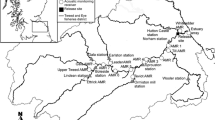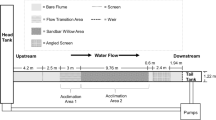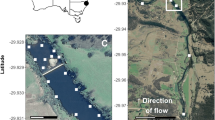Abstract
Degradation and destruction of valuable spawning and rearing habitat due to anthropogenic changes (e.g., flow modification and channelisation) is known to have dramatic impacts on fish populations. To compensate for habitat losses due to hydropower development, an artificial fluvial habitat channel (‘Compensation Creek’) was constructed in south-central Newfoundland, Canada. The creek was designed to include appropriate habitat features for the two dominant salmonid fish species, landlocked Atlantic salmon (Salmo salar L.) and brook charr (Salvenius fontinalis Mitchell). The study examines the habitat use of landlocked Atlantic salmon and brook charr in the Compensation Creek using electromyogram (EMG) radio telemetry. Ten landlocked Atlantic salmon and eight brook charr were captured and tagged with EMG transmitters. In laboratory swimming experiments, the EMG values were calibrated against swimming speed. Fish were then released in the Compensation Creek and tracked on a daily basis. The results show that (1) during residence in the creek, both species used preferentially the habitat features designed to match their rearing habitat preferences, and (2) swimming speed did not vary among habitat types for either species.




Similar content being viewed by others
References
AMEC, 2001. Granite Canal Hydroelectric Development Fish Habitat Compensation Plan. Prepared for Newfoundland and Labrador Hydro, St. John’s, NL.
Bain, M. B., J. T. Finn & H. E. Booke, 1988. Streamflow regulation and fish community structure. Ecology 69: 382–392.
Beamish, F. W. H., 1978. Swimming Capacity. In Hoar W. S. & J. R. Randall (eds), Fish Physiology—Locomotion, vol. VII. Academic Press, New York, 101–187.
Bell, W. H. & L. D. B. Terhune, 1970. Water tunnel design for fisheries research. Fisheries Research Board of Canada Technical Report 195: 1–69.
Booth, R. K., R. S. McKinley, F. Økland & M. M. Sisak, 1997. In situ measurement of swimming performance of wild Atlantic salmon (Salmo salar) using radio transmitted electromyogram signals. Aquatic Living Resources 10: 213–219.
Briggs, C. T. & J. R. Post, 1997. In situ activity metabolism of rainbow trout (Oncorhynchus mykiss): Estimates obtained from telemetry of axial muscle electromyograms. Canadian Journal of Fisheries and Aquatic Sciences 54: 859–866.
Bunt, C. M., 1999. A tool to facilitate implantation of electrodes for electromyographic telemetry experiments. Journal of Fish Biology 55: 1123–1128.
Cooke, S. J., E. B. Thorstad & S. G. Hinch, 2004. Activity and energetics of free-swimming fish: insights from electromyogram telemetry. Fish and Fisheries 5: 21–52.
Cowx, I. G. & R. A. Gould, 1989. Effects of stream regulation on Atlantic salmon, Salmo salar L., and brown trout, Salmo trutta L., in the upper Severn catchment, UK. Regulated Rivers: Research & Management 3: 235–245.
DesLandes, J. C., S. Guenette, Y. Prairie, D. Roy, R. Verdon & R. Fortin, 1995. Changes in fish populations affected by the construction of the La Grande complex (Phase I), James Bay region, Quebec. Canadian Journal of Zoology 73: 1860–1877.
DFO, 1986. The Department of Fisheries and Oceans policy for the management of fish habitat. DFO, Ottawa.
European Parliament & Council of the European Union, 2000. Directive 2000/60/EC of the European Parliament and of the Council of 23 October 2000 establishing a framework for Community action in the field of Water Policy. Official Journal of the European Communities, L 327/1–72.
Hinch, S. G. & J. Bratty, 2000. Effects of swim speed and activity pattern on success of adult sockeye salmon migration through an area of difficult passage. Transactions of the American Fisheries Society 129: 598–606.
Ivlev, V. S., 1961. Experimental ecology of the feeding in fishes. Yale University Press, NewHaven.
Langton, R. W., R. S. Steneck, V. Gotceitas, F. Juanes & P. Lawton, 1996. The interface between fisheries research and habitat management. North American Journal of Fisheries Management 16: 1–7.
Minns, C. K., 1997. Quantifying ‘no net loss’ of productivity of fish habitats. Canadian Journal of Fisheries and Aquatic Sciences 54: 2463–2473.
Økland, F., B. Finstad, R. S. McKinley, E. B. Thorstad & R. K. Booth, 1997. Radio-transmitted electromyogram signals as indicators of physical activity in Atlantic salmon. Journal of Fish Biology 51: 476–488.
Poff, N. L., J. D. Allan, M. B. Bain, J. R. Karr, K. L. Prestegaard, B. D. Richter, R. E. Sparks & J. E. Stromberg, 1997. The natural flow regime: a paradigm for river conservation and restoration. Bioscience 47: 769–784.
Saltveit, S. J., J. H. Halleraker, J. V. Arnekleiv & A. Harby, 2001. Field experiments on stranding in juvenile Atlantic salmon (Salmo salar) and brown trout (Salmo trutta) during rapid flow decreases caused by hydropeaking. Regulated Rivers: Research & Management 17: 4–5.
Scruton, D. A. & L. J. LeDrew, 1997. A retrospective assessment of the flow regulation of the West Salmon River, Newfoundland, Canada. Fisheries Management & Ecology 4: 467–480.
Thorstad, E. B., F. Økland & B. Finstad, 2000. Effects of telemetry transmitters on swimming performance of adult Atlantic salmon. Journal of Fish Biology 57, 531–535.
Acknowledgements
We thank C. Kelly (Fisheries and Oceans Canada) for assistance in the field, J. McCarthy (AMEC) for information on spawning activity and rearing habitat, S. Finucan (Ontario Ministry of Natural Resources) for providing telemetry equipment and the Environmental Services and Properties Department of Newfoundland and Labrador Hydro for in-kind and financial support at the Granite Canal Hydro Development. This research was funded by Natural Resources Canada’s (NRCan) Panel for Energy Research and Development (PERD), Northeast Science and Information Section of the Ontario Ministry of Natural Resources and Brascan Power Limited. E.C. Enders was supported by a Visiting Fellowship in Canadian Government Laboratories from the Natural Sciences and Engineering Research Council of Canada (NSERC).
Author information
Authors and Affiliations
Corresponding author
Rights and permissions
About this article
Cite this article
Enders, E.C., Smokorowski, K.E., Pennell, C.J. et al. Habitat use and fish activity of landlocked Atlantic salmon and brook charr in a newly developed habitat compensation facility. Hydrobiologia 582, 133–142 (2007). https://doi.org/10.1007/s10750-006-0550-0
Issue Date:
DOI: https://doi.org/10.1007/s10750-006-0550-0




